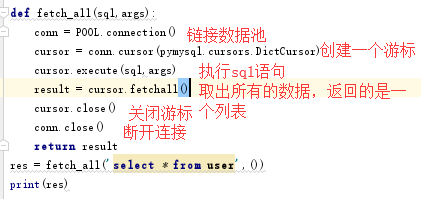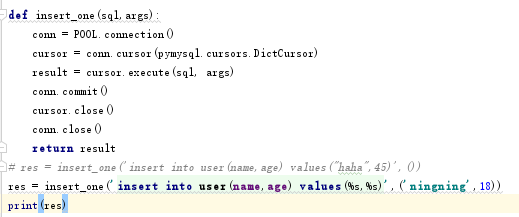内容回顾:
1.Flask-Session
from flask import session
from flask_session import Session
app.config["SESSTION_TPYE"] = "redis"
app.config["SESSTION_REDIS"] = Redis("ip",port,db=1)
# select 1 ----- [1]
Session(app)
session["key"] = "value"
session["key"]
2.Flask CBV
class Index(views.MethodView):
methods = ["GET"]
decorators = [a,b,c]
def get():
return "file"
app.add_url_rule("/",endpoint="index",view_func=Index.as_view(name="index"))
if 1 : endpoint = None = name = "index"
elif 2: endpoint="index" != name="index123"
3.Flask WTForms
from wtforms import Form,validators,widgets
from wtforms.fields import simple
class LgoinForm(Form):
username = simple.StringField(
label = "用户名",
validators=[
validators.DataRequired(message="用户名不能为空"),
],
widget = widgets.TextInput(),
render_kw = {"class":"jinwangba"}
)
def a():
"GET":
return render_template("a.html",fm = LgoinForm())
"POST":
request.form
lfm = LgoinForm(request.form)
lfm.validate() true false
{{ fm.username.label }} {{ fm.username }} {{ fm.username.errors.0 }}
flask回顾:
# 1.路由@app.route('/',methods=["GET","POST"],endpoint="helloWorld",strict_slashes=True)
# 动态路由参数 /<arg> def viewfunc(arg)
# url_for
# 2.三贱客:
# HTTPResponse return 'Hello World!'
# render retrun render_template("index.html")
# redirect retrun redirect("/login")
# 3.request
# 存放数据:
# request.form # 从表单 FormData 获取到的数据
# request.args # URL传参时 获取到的数据
# request.json # Content-Type:application/json 获取数据
# request.data # b"" Content-Type:xiaowangba 获取数据
# 请求属性的
# request.method = "GET"/"POST"
# request.path = "/index"
# request.url = "http://127.0.0.1:5000/index"
# 坑
# request.values.to_dict() 同名被GET(args)覆盖
# 4.session : Flask-Session
# app.secret_key = "加密字符串"
# 存放在浏览器Cookies中的被序列化后的session
# session["key"] = "value"
# session["key"]
# session 默认31天的生命周期
# 5.Blueprint
# 蓝图对象 可以理解为 一个不可以被启动的Flask对象
# bp = Blueprint("bluename",__name__,template_folder="temp_blue")
# @bp.route("/blue")
# app.register_blueprint(blueprint.bp)
# 6.Flask配置
# 1.Flask对象实例配置
# class Obj(object):
# DEBUG = True
# SESSION_TYPE = "redis"
# SESSION_REDIS = Redis(db=5)
# app.config.from_object(Obj)
# 2.Flask初始化的配置
# template_folder = 模板文件存放路径
# static_folder = "静态文件存放路径"
# static_url_path = "/静态文件URL访问地址"默认是static_folder
# 7.Flask Jinja2
# {{ }} 当引用变量 和 执行函数的时候 , 非逻辑引用
# {% %} if for 逻辑代码引用
# obj.name obj.get("name") obj["name"] obj_list.1 obj_list[1]
# Markup | safe
# @app.template_global()
# @app.template_filter()
# 8.before_request after_request errorhandler(404,500)
# @app.before_request 多个before_request依次执行
# def be1():
# return None
# @app.after_request 多个after_request,反序执行
# def af1(response)
# return response
# 正常情况: be1-be2-af2-af1
# 异常情况: be1-af2-af1
# @app.errorhandler(404) 重定义错误信息
# 9.flash
# flash("be_fr1")
# get_flashed_messages()
# 10.send_file jsonify
# send_file("文件路径") 打开并返回文件内容
# jsonify({k:v}) 将字典序列化json,打包一个Content-Type:application/json 返回给客户端
# 11.Flask CBV
# class Index(views.MethodView):
# methods = ["GET"]
# decorators = [a,b,c]
# def get():
# return "file"
#
#
# app.add_url_rule("/",endpoint="index",view_func=Index.as_view(name="index"))
#
# if 1 : endpoint = None = name = "index"
# elif 2: endpoint="index" != name="index123"
1.DBUtils 数据库连接池
首先下载插件pip install DBUtils或者python3 -m pip install DBUtils,
然后运行mysql数据库,在mysql新创建一个数据库,并创建一个新的表,录入数据。
import pymysql from DBUtils.PooledDB import PooledDB POOL = PooledDB( creator=pymysql, # 使用链接数据库的模块 maxconnections=6, # 连接池允许的最大连接数,0和None表示不限制连接数 mincached=2, # 初始化时,链接池中至少创建的空闲的链接,0表示不创建 maxcached=5, # 链接池中最多闲置的链接,0和None不限制 maxshared=3, # 链接池中最多共享的链接数量,0和None表示全部共享。PS: 无用,因为pymysql和MySQLdb等模块的 threadsafety都为1,所有值无论设置为多少,_maxcached永远为0,所以永远是所有链接都共享。 blocking=True, # 连接池中如果没有可用连接后,是否阻塞等待。True,等待;False,不等待然后报错 maxusage=None, # 一个链接最多被重复使用的次数,None表示无限制 setsession=[], # 开始会话前执行的命令列表。如:["set datestyle to ...", "set time zone ..."] ping=0, # ping MySQL服务端,检查是否服务可用。 # 如:0 = None = never, # 1 = default = whenever it is requested, # 2 = when a cursor is created, # 4 = when a query is executed, # 7 = always host='127.0.0.1', # 主机 port=3306, # 端口 user='root', # 用户 password='', # 密码 database='s12day113', # 创建的数据库的名字 charset='utf8' )

也可以查询单条信息:

也可以插入一条数据:

2.Flask请求上下文,应用上下文

